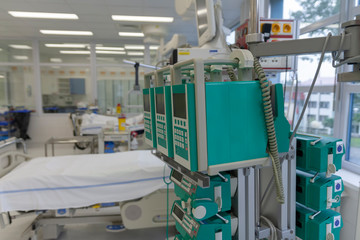An infusion pump is a modern medical equipment that is currently used to allow the movement of fluids used in medicine such as solutions, drugs, blood or their derivatives through a tube in the direction of the patient’s vascular system, allowing these fluids to be administered more accurately. Offering more ease in the parenteral administration of drugs and solutions, in conditions where the accuracy and constant supply of any drug or medicine is key.
These devices allow very small volumes to be managed in a very secure manner that could not otherwise be employed. And they have a simple program through which it is coordinated that the patient can receive his infusion at the right time. In this way thanks to the use of infusion pumps, a wide variety of chemical compounds can be easily administered, and at present there are several types of infusion pumps that are classified according to flow control in syringe, volumetric and fluxometric.
How does an infusion pump work?
An infusion pump uses mechanical pressure to overcome the resistance to flow. This equipment is programmed to generate pressure on the injected line in the patient. It is able to mobilize the medicine or solution from the external environment to the patient’s circulatory torrent.
In general, infusion pumps allow the volume to be programmed and give an alarm when this volume is reached, if the medicine or substance is not finished. Many infusion pumps can handle several solutions simultaneously and independently. When a pump handles two or more solutions with independent infusion controls, it has two or more channels.
Uses of an infusion pump
Usually the use of an infusion pump is intravenous, although there are subcutaneous, arterial and epidural infusions, which can also be used depending on the medical indication. They are used for their ability to administer drugs and solutions at high pressures that cannot be achieved with another device operated manually or severely dependent, such as during the administration of intra-arterial drugs, or very fast flows of solutions during resuscitation (200-1000 ml/h).
An infusion pump is used when it is essential to give the patient a specific amount of a drug at a certain rate or for a specified amount of time. There are many clinical conditions where infusion pumps have been shown to be much more efficient than traditional drug delivery methods. They are very useful equipment in the application of intravenous inotropics, parenteral and enteral feeding solutions, chemotherapy, epidural analgesics, subcutaneous insulin administration and self-transfusion.
What advantages does the use of infusion pumps offer?
- They allow for greater accuracy in drip rate than gravity systems via a flow-regulating clamp.
- They save nursing staff time, as with the use of pumps it is not necessary to be regulating the flow of the drip.
- They allow all kinds of solutions, blood and its derivatives, drugs and parenteral and enteral infusions to be administered. These are equipment that fits the needs of the patient, and some of them are portable.
What do we offer you in Kalstein?
Kalstein is a company MANUFACTURER of medical and laboratory equipment of the highest quality and that have the most advanced technology at the best prices in the market, so we guarantee you a safe and effective purchase, knowing that you have the service of a solid company and committed to health. This time we present our Infusion Pump YR05164. This new equipment has the following characteristics:
- Type of drip pumping.
- Large LCD display, with backlight, suitable for working in various ambient light conditions.
- Disposable intravenous equipment of any brand is suitable for this pump
- Three working modes: rate/volume/time mode
- Purge, KVO function
- The heating function is optional, suitable for infusing in winter or if there is a requirement for the temperature of the drug.
- The central monitoring system is optional, the infusion status of each pump is displayed in real time at the central station via wireless transmission.
- Simple and convenient in operation, intuitive presence of working state.
- Audible and Visible Alarms
- Alarm: Full infusion, vacuum, faulty signal, malfunction, occlusion, door open, air bubble, low battery, setup error, AC power off, idle.
That’s why we invite you to take a look HERE

